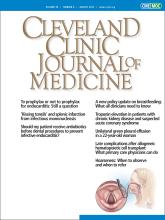
On the surface, the question does not seem complicated. Infective endocarditis (IE) is a bad disease. In most published case series, viridans streptococci of presumed oral origin are the second most common causative bacterial agents (Staphylococcus is the most common), invasive dental procedures release these and other bacteria into the bloodstream, and well-tolerated, inexpensive oral antibiotics such as amoxicillin are effective therapy. Thus, it “makes sense” to prophylax with antibiotics before an invasive dental procedure.
Many guidelines have been written about this over the past half-century. They have evolved in some ways to be simpler (a shorter oral antibiotic course), but in some ways to be more complex (basing the need for prophylaxis on specific patient risk factors). Currently, there is no uniformity among guidelines worldwide, even though they are based on the same available published data. As with many practice guidelines and recommendations, what would seem to “make sense” may not be fully supported or refuted with robust data sufficient to meet the rules of each guideline-writing committee.
In this issue of the Journal, McCartney et al1 have synthesized the available information into pragmatic recommendations on the prevention of IE and prosthetic joint infections related to dental procedures.
The question of prophylaxis, simply addressed, is one of risks and benefits. What are the risks and costs of a single dose of antibiotic for the individual patient and to society, and how much IE can be prevented by antibiotic prophylaxis? At least in the United States, decisions like this have medicolegal implications and are not exempt from attribution of culpability if adverse outcomes occur, but I don’t intend to discuss that facet of the decision process here.
IE, unrelated to medical or nonmedical intravenous manipulations, is an uncommon condition, and not all episodes are caused by bacteria of oral origin. Hence, there are no great prospective randomized controlled trials to assist guideline-writing committees. The authors of a 2023 systematic review of the literature2 found a single cohort study that met their criteria and opined that the evidence supporting or discouraging antibiotic prophylaxis before dental procedures to prevent IE is “very low.”2
While there is and should be concern regarding any unnecessary antibiotic use, the likelihood of a significant adverse outcome attributable to a single dose of amoxicillin seems low, assuming patients are asked about any history of a significant allergic reaction. Yet the cumulative effect of multiple doses over time in a population is likely incalculable.
There are clinically intriguing aspects of the ongoing dialogue that begin with learning more about the biology of the oral microbiome3 and about bacteremia resulting from dental procedures and daily gum trauma, as well as from indirect data accumulated mainly from observational studies evaluating antibiotic prophylaxis and IE.
Questions persist as to how to react to the data regarding bacteremia after infrequently performed invasive dental procedures vs bacteremia associated with normal dental hygiene such as daily toothbrushing. In an interesting temporal evaluation of bacteremia after a single routine brushing, single dental extraction with amoxicillin prophylaxis, or single extraction without antibiotic, there was no huge clinical difference in the occurrence and persistence of bacteremia with strains known to be associated with IE.4 The incidence of bacteremia was 23%, 33%, and 60% in the toothbrushing, dental extraction with amoxicillin, and dental extraction without antibiotic groups, respectively. Notably, the duration of bacteremia was less than 20 minutes in greater than 90% of the 290 study volunteers, and only 2% of the brushing group and 5% of the extraction without antibiotic group had ongoing low-level blood culture growth at 60 minutes.4
Considering that people with good dental hygiene generally brush twice daily, the cumulative exposure to oral bacteria in the bloodstream from routine dental care is numerically far more likely to be associated with IE than invasive procedures including extractions. The risk is even greater in those with suboptimal dental health. Patients with poor dental hygiene may brush and floss less frequently, but the degree of bacteremia is greater with each brushing in those with more plaque and periodontal disease.5 Doing the arithmetic, it is surprising that there is not a higher prevalence of IE in the general population. We have more to learn regarding the successful clearance of bacteria from the bloodstream and why those protective mechanisms occasionally fail.
Given the above complexities and the dearth of hard data showing a benefit of prophylaxis, the UK guidelines in 2008 and subsequent Swedish guidelines in 2012 did not recommend antibiotic prophylaxis before invasive dental procedures, even for patients deemed at high risk for IE. Vähäsarja et al6 conducted a cohort study analysis to see if there was an increase in IE after the change in the Swedish guidelines: the authors noted a 40% reduction in antibiotic prescriptions written by dentists, but no significant increase in IE. There are multiple caveats to consider when interpreting this analysis, and a study of similar design in England7 performed after the UK guidelines rescinded the recommendation for prophylaxis, did report an increased incidence in IE in high-risk patients.
So what seems simple is apparently not. Nor in this case is the definition of what “makes sense.”
- Copyright © 2023 The Cleveland Clinic Foundation. All Rights Reserved.






